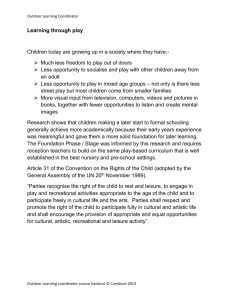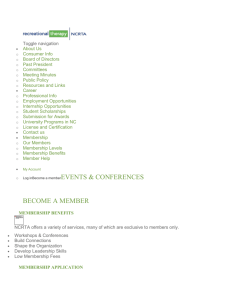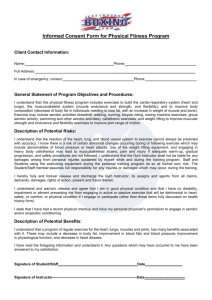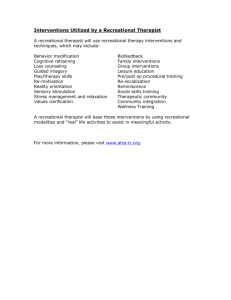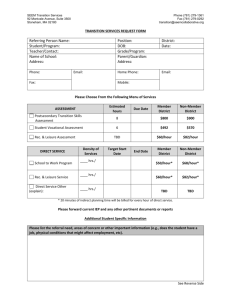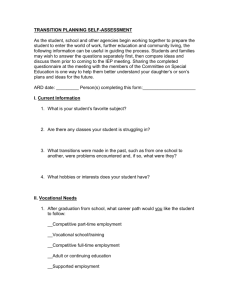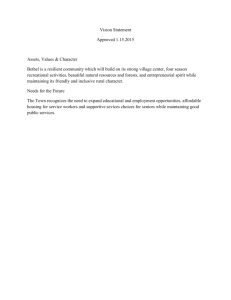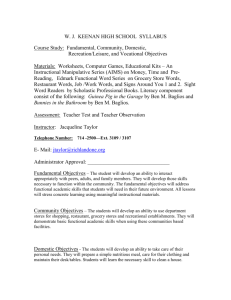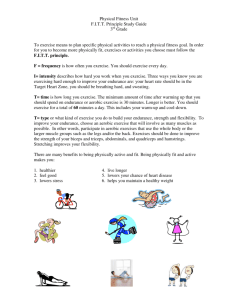Differences in the Direct and Indirect Cost of Medical Expenditure... Adults Participating in Different Types of Recreational Activities
advertisement
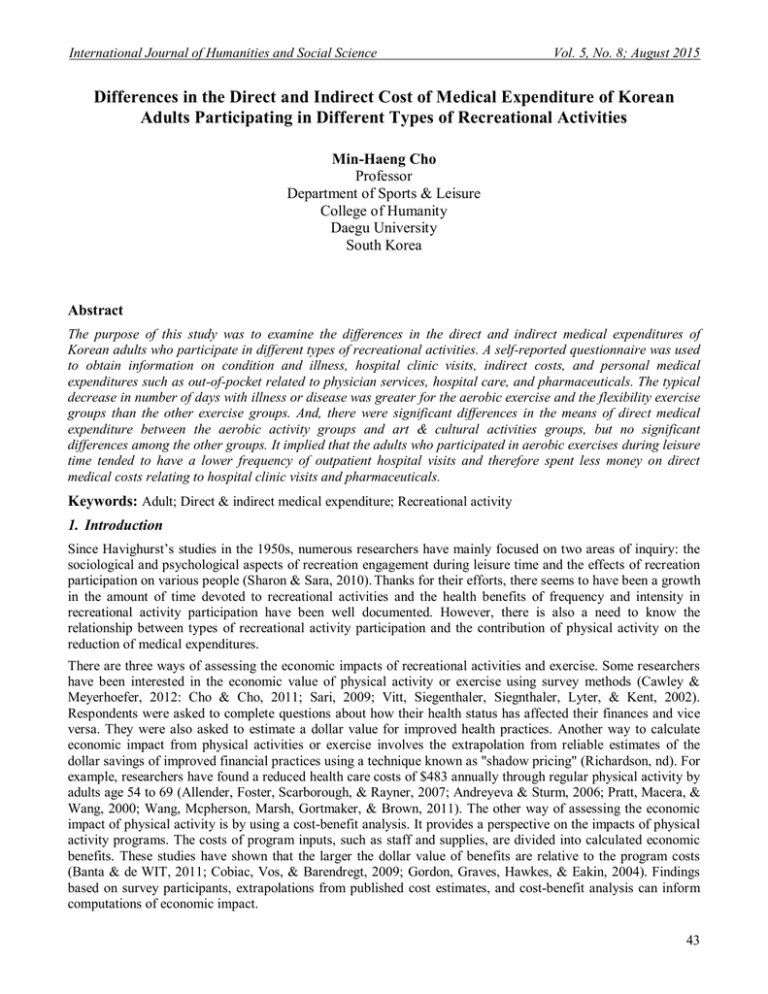
International Journal of Humanities and Social Science Vol. 5, No. 8; August 2015 Differences in the Direct and Indirect Cost of Medical Expenditure of Korean Adults Participating in Different Types of Recreational Activities Min-Haeng Cho Professor Department of Sports & Leisure College of Humanity Daegu University South Korea Abstract The purpose of this study was to examine the differences in the direct and indirect medical expenditures of Korean adults who participate in different types of recreational activities. A self-reported questionnaire was used to obtain information on condition and illness, hospital clinic visits, indirect costs, and personal medical expenditures such as out-of-pocket related to physician services, hospital care, and pharmaceuticals. The typical decrease in number of days with illness or disease was greater for the aerobic exercise and the flexibility exercise groups than the other exercise groups. And, there were significant differences in the means of direct medical expenditure between the aerobic activity groups and art & cultural activities groups, but no significant differences among the other groups. It implied that the adults who participated in aerobic exercises during leisure time tended to have a lower frequency of outpatient hospital visits and therefore spent less money on direct medical costs relating to hospital clinic visits and pharmaceuticals. Keywords: Adult; Direct & indirect medical expenditure; Recreational activity 1. Introduction Since Havighurst’s studies in the 1950s, numerous researchers have mainly focused on two areas of inquiry: the sociological and psychological aspects of recreation engagement during leisure time and the effects of recreation participation on various people (Sharon & Sara, 2010). Thanks for their efforts, there seems to have been a growth in the amount of time devoted to recreational activities and the health benefits of frequency and intensity in recreational activity participation have been well documented. However, there is also a need to know the relationship between types of recreational activity participation and the contribution of physical activity on the reduction of medical expenditures. There are three ways of assessing the economic impacts of recreational activities and exercise. Some researchers have been interested in the economic value of physical activity or exercise using survey methods (Cawley & Meyerhoefer, 2012: Cho & Cho, 2011; Sari, 2009; Vitt, Siegenthaler, Siegnthaler, Lyter, & Kent, 2002). Respondents were asked to complete questions about how their health status has affected their finances and vice versa. They were also asked to estimate a dollar value for improved health practices. Another way to calculate economic impact from physical activities or exercise involves the extrapolation from reliable estimates of the dollar savings of improved financial practices using a technique known as "shadow pricing" (Richardson, nd). For example, researchers have found a reduced health care costs of $483 annually through regular physical activity by adults age 54 to 69 (Allender, Foster, Scarborough, & Rayner, 2007; Andreyeva & Sturm, 2006; Pratt, Macera, & Wang, 2000; Wang, Mcpherson, Marsh, Gortmaker, & Brown, 2011). The other way of assessing the economic impact of physical activity is by using a cost-benefit analysis. It provides a perspective on the impacts of physical activity programs. The costs of program inputs, such as staff and supplies, are divided into calculated economic benefits. These studies have shown that the larger the dollar value of benefits are relative to the program costs (Banta & de WIT, 2011; Cobiac, Vos, & Barendregt, 2009; Gordon, Graves, Hawkes, & Eakin, 2004). Findings based on survey participants, extrapolations from published cost estimates, and cost-benefit analysis can inform computations of economic impact. 43 ISSN 2220-8488 (Print), 2221-0989 (Online) ©Center for Promoting Ideas, USA www.ijhssnet.com Because these various methods of estimating the economic value of physical activities have been utilized, therefore a study that focuses on the relationship between recreational activity types and direct individual (out-ofpocket) medical expenditures is required. This is especially true because there is a considerable economic burden due to the increase of chronic diseases relating to unhealthy behaviours in the adult population in developing countries. Therefore, the author aimed to examine the differences in the direct and indirect medical expenditures by examining the different types of recreational activities participated by Korean adults. 2. Methods After obtaining an ethical clearance by the authentic ethical committee of Daegu University, copies of the survey questionnaires were distributed to each of the 100 participants in community centers from the four different centers in Gyeongsan, South Korea. The written consent forms and questionnaires were distributed to participants by the researcher. The participants were informed that participation in the study was voluntary and they were free to withdraw from the study at any time. The sample included South Korean adults aged over 20 who were currently participating in recreational activities provided by the community centers (senior center, residential culture center, sport center, and YWCA center) in Gyeongsan, South Korea. These centers provide recreational activity programs for the residents. The author used a multistage cluster sampling technique to select representative samples. Of the 400 questionnaires distributed, all were returned, but 18 questionnaires were deemed unusable because of duplicate or incomplete responses. This left 382 completed surveys with a return rate of 95.5%. Out of this number, 105 (27.5%) were males while 277 (72.5%) were females. The respondents ranged in age from 20 to 80 years. The author excluded the subjects who had functional limitations or chronic conditions interfering with physical activity. The questionnaire consisted of three sections: demographics, recreational activity types during leisure time, and direct and indirect cost of medical expenditures. In the section types of recreational activities there was a request to respond to a simple five-item query of recreational activities based on the studies (Cho, 2004; Cho & Cho, 2011). The first question was to identify the type of recreational activities of the adults’ participating in their leisure time. An expert panel in the field of sports & leisure and recreation were invited to classify the activities into five different types of recreational activities. The categorizations of recreational activities were aerobic exercise groups, flexibility exercise groups, muscular exercise groups, arts & cultural activities groups, and simple entertainments. A self-reported questionnaire based on the studies was developed to obtain information on conditions and illness, hospital clinic visits, indirect costs, and personal medical expenditures such as out-of-pocket related to physician services, hospital care, and pharmaceuticals (Cho & Cho, 2011; National Health Insurance Corporation, 2008). For this study, direct costs included out-of-pocket relating to hospital clinic visits and pharmaceuticals except Medicare, Medicaid, and private insurance payments. Respondents were asked to report direct medical expenditures including physicians and drug costs for the last one month. Indirect costs included loss of activity participation from sickness and absence from the recreational activity programs or work measured by the monthly number of sick days. Respondents were asked to report frequency of health care visits for the last month. A pilot study was conducted for 30 Korean adults. The purpose of this pilot study was to test the procedures used to conduct the survey and to make sure respondents understood what they were being asked. The content validity required several specific procedures. First, an item pool was generated. Second, the instrument was constructed and then evaluated by the author. Third, the instrument was sent to a panel of recognized experts in the field of recreation, medical, and social services. The selected experts were asked to evaluate and comment on the initial questionnaire with regard to: the clarity of questions; the appropriateness of the items included within each question; and the overall applicability of the survey instrument. Finally, comments were noted and appropriate revisions were made. Statistical analyses were performed using the Statistical Package used for the Social Sciences (SPSS 12.0/PC Windows computer software). Descriptive statistics were used to analyze recreational activities during leisure time. In order to examine the differences in the number of hospital clinic visits among different types of recreational activities, data was analyzed using a two-way contingency table analysis. In addition, a one-way variance test was also conducted to examine the differences in direct medical expenditures of Korean adults who participate in different types of recreational activities. A significance level of p<.05 was established to identify significant differences. 44 International Journal of Humanities and Social Science Vol. 5, No. 8; August 2015 3. Results Table 1 shows a summary of recreational activity participation among adults. Of the respondents, the most common activities reported by them were aerobic exercises (37.2 %), arts & cultural activities (24.9 %), flexibility exercises (13.9 %), simple entertainments (12.0 %), and muscular exercises (12.0 %). Table 1: Frequency of Recreational Activity Participation Recreational activity Aerobic exercises (a) Flexibility exercises (b) Muscular exercises (c) Art & cultural activities (d) Simple entertainments (e) Frequency 142 53 46 95 46 Percent 37.2 13.9 12.0 24.9 12.0 A two-way contingency table analysis was conducted to examine the differences in the frequency of hospital clinic visits because of illness or disease among the recreational activity types and, which were found to be significantly different [Pearson 2 (4, N=382)=21.14, p=.00]. The proportions of adults who visited a hospital clinic after they participated in aerobic exercises, flexibility exercises, muscular exercises, arts & cultural activities, simple entertainments, and travel and tourism activities in their leisure time were .32, .65, .29, .40, and .51, respectively. Follow-up pair-wise comparisons were conducted to evaluate the difference among these proportions. Table 2 shows the results of these analyses. The Holm’s sequential Bonferroni method was used as a control for type I errors at .05 across all ten comparisons. The results of these tests indicated four out of the ten pair-wise differences were significant: the difference between the aerobic exercise groups and the flexibility exercise groups, the difference between the aerobic exercise groups and the simple entertainment groups, the difference between the flexibility exercise groups and the muscular exercise groups, and the difference between the flexibility exercise groups and the arts & cultural activities groups. The typical decrease in number of days with illness or disease was greater for the aerobic exercise groups and the flexibility exercise groups than the other exercise groups. Table 2: Pairwise Comparisons of Recreational Activity Types and Sickness Absence Days Variance Hospital clinic visit Comparison Aerobic exercise group vs flexibility exercise group Aerobic exercise group vs muscular exercise group Pearson chi-square 17.720 p-value .001 Cramer's V .293 .116 .734 .026 Aerobic exercise group vs arts & cultural activity group Aerobic exercise group vs simple entertainment group Flexibility exercise group vs muscular exercise group Flexibility exercise group vs arts & cultural activity group Flexibility exercise group vs simple entertainment group Muscular exercise group vs arts & cultural activity group Muscular exercise group vs simple entertainment group Arts & cultural activity group vs simple entertainment group 1.359 .244 .072 5.494 .019 .165 8.184 .004 .335 9.577 .002 .245 2.087 .149 .145 .854 .355 .082 2.978 .084 .209 1.86 .173 .112 45 ISSN 2220-8488 (Print), 2221-0989 (Online) ©Center for Promoting Ideas, USA www.ijhssnet.com A one-way variance test was conducted to examine the differences in direct medical expenditures of Korean adults who participated in the different types of recreational activities. The independent variable, the recreational activity factor, included five levels: aerobic exercise groups, flexibility exercise groups, muscular exercise groups, art & cultural activities groups, and the simple entertainment groups. The dependent variable was the direct medical expenditures defined as direct payments for hospital inpatient care, hospital outpatient care, and the purchase of prescribed medications. The ANOVA test was significant, F (4, 375) = 3.265, p = .012. Follow-up tests were conducted to evaluate pairwise differences among the means. The results of these tests, as well as the means and standard deviations for the five recreational activity types are reported in Table 3. There were significant differences in the means of direct medical expenditure between the aerobic activities groups and the art & cultural activities groups, but no significant differences in the means of direct medical expenditure between the other recreational activities groups. Table 3: Differences in the Direct Medical Expenditures by Recreational Activity Types Recreational activity Aerobic exercises (a) Flexibility exercises (b) Muscular exercises (c) Art & cultural activities (d) Simple entertainments (e) Total N 142 53 46 95 46 382 M 4309.2 8175.5 6773.9 11598.8 6571.7 7227.7 SD 13790.6 16466.2 13288.8 19523.9 10357.6 15591.7 F 3.265 P .012 Follow-up test .003 (a, d) 4. Discussion The purpose of this study was to examine the differences in direct and indirect medical expenditures of Korean adults who participated in the different types of recreational activities. The results of this study showed a significant difference between the recreational activities types (aerobic exercises, flexibility exercises, muscular exercises, arts & cultural activities, and simple entertainments) and the number of hospital clinic visits, which refers to personal indirect medical expenditures. It was revealed that the typical decrease in number of days with illness or injury was greater for the aerobic exercise groups than for the other activities groups (the flexibility exercise groups, muscular exercise groups, arts and cultural activities groups, and the simple entertainment groups). The aerobic exercise participants were found to have significantly fewer outpatient (including emergency) visits to the hospital in comparison to the participants from the other groups of different types of recreational activities. The findings from this study indicated that the aerobic exercise groups had better health, as it is indicated by the lower frequency of outpatient and emergency hospital visits. Additionally, this study shows a statistically significant difference between the aerobic activities groups and the arts & cultural activities groups, but no significant differences in the means of the direct medical expenditure between the other recreational activities groups. The total monthly spending for physicians and drug costs in the aerobic exercise groups (Mean = 4,309 Won; 4.6 US$ in 2012) is lower than the other activities groups, the flexibility exercise groups (Mean = 8,175 Won; 7.7 US$ in 2012), the muscular exercise groups (Mean= 6,773 Won; 6.3 US$ in 2012), the arts & cultural activities groups (Mean = 11,598 Won; 10.9 US$ in 2012), and the simple entertainment groups (Mean = 6,571 Won; 6.2 US$ in 2012). The early study suggested that providing twice-weekly exercise classes for 10,000 participants would cost approximately £854,700 per year and the cost per life-year saved would vary from £100 to £1,500 (Munro, Brazier, Davey, & Nicholl, 1997). A subsequent study on the impacts of walking upon medical care expenditure has shown a decrease in medical care expenditure (Tsuji, Takahashi, Nishino, Ohkubo, Kuriyama, Watanabe, Anzai, Tsubono, & Hisamichi, 2003). Since the study of aerobic exercise as an independent factor for major chronic diseases began in the 1980s, there is strong evidence that aerobic exercise can benefit people with chronic diseases. Each year, new studies identify consistent and stronger associations between cardiovascular exercises and health benefits (Bauman & Owen, 2009; Powell & Pratt, 1996). In particular, after an adjustment in several studies for confounding factors which also contribute to disease such as hyperlipidemia, hypertension and obesity, there are independent favorable effects of cardiovascular fitness upon disease states. In addition, aerobic exercises such as walking or running play a vital role in the amelioration of weight maintenance, increasing HDL cholesterol and reducing blood pressure (Friesner, Mcpherson, Patil, 2008; Trogdon, Finkelstein, Hylands, Dllea, & Kamal-Bahl, 2008). 46 International Journal of Humanities and Social Science Vol. 5, No. 8; August 2015 The results of the previous studies support the finding of this study that aerobic exercise provides more health benefit than the other activities groups such as arts & cultural activities and simple entertainments. It implied that adults who participate in aerobic exercises during leisure time tended to have a lower frequency of outpatient hospital visits due to diseases or illnesses and to support the contribution of exercise to the reduction of medical expenditures. In summary, relating to the study on the differences in frequency of hospital clinic visits and direct medical expenditures among recreational activities types, this study supports that aerobic exercises provides more health benefits than the other activities groups such as flexibility exercises, muscular exercises, arts & cultural activities, and simple entertainments. It also implied that adults who participate in aerobic exercises during leisure time tended to have a lower frequency of outpatient hospital visits and therefore spend less money on the direct medical expenditures relating to hospital clinic visits and pharmaceuticals. Explanations for the difference in the direct and indirect medical expenditures with regard to the types of recreational activities participation seem to lie in the values of cardiovascular fitness. This study has some limitations. Firstly, recreational activities types or classification during leisure time is affected by the approaches used to define and measure the recreational activities during leisure time in a given study. There are many activities that could fit into two or more categories. The purpose of the classification of recreational activities is to place every single recreational activity into its appropriate category. The second limitation concern was the research method relating to methodological issues. The various factors associated with medical expenditure have made it difficult to calculate accurately. This study utilized self-reported measures of indirect and direct medical expenditures, with considerable variability in the respondent’s memory of frequency of outpatient visits. Future studies should use additional research methods such as case studies and longitudinal studies to clarify the economic value of recreational activity types for direct medical expenditures. Acknowledgement This research was supported by Daegu University Research Grant, 2011. 47 ISSN 2220-8488 (Print), 2221-0989 (Online) ©Center for Promoting Ideas, USA www.ijhssnet.com References Allender, S., Foster, C., Scarborough, P., & Rayner, M. (2007). The burden of physical activity- related ill health in the UK. Journal of Epidemiology Community Health, 61(4), 344- 348. Andreyeva, T., & Sturm, R. (2006). Physical activity and changes in health care costs in late middle age. Journal of Physical Activity Health, 3, S6-S19. Banta, H. D., & de WIT, G. A. (2008). Public health services and cost-effectiveness analysis. Annual Review of Public Health, 29, 383-397. Bauman, A., & Owen, N. (1999). Physical activity of adult Australians: Epidemiological evidence and potential strategies for health gains. Journal of Science and Medicine in Sport, 2, 30–41. Cawley, J., & Meyerhoefer, C. (2012). The medical care costs of obesity: an instrumental variables approach. Journal of Health Economics, 31, 219-230. Cho, M. H. (2004). The strength of motivation and physical activity level during leisure time among youth in South Korea. Journal of Youth Society, 35(4), 480-494. Cho, M. H., & Cho, B. J. (2011). A case study of physical activity levels and medical expenditure of the Korean middle aged. South African Journal for Research in Sport, Physical Education and Recreation, 33(2), 3544. Cobiac, L. J., Vos, T., & Barendregt, J. J. (2009). Cost-effectiveness of interventions to promote physical activity: a modeling study. PLoS Medicine, 6(7), 1-11. Friesner, D. L., Mcpherson, M. Q., & Patil, V. H. (2008). Focusing your walking intervention’s Message. California Journal of Health Promotion , 6(1), 73-86. Gordon, L. G., Graves, N., Hawkes, A., & Eakin, E. (2007). A review of the cost-effectiveness of face-to-face behavioral interventions for smoking, physical activity, diet and alcohol. Chronic Illness, 3,101–129. Munro, J., Brazier, J., Davey, R., & Nicholl, J. (1997). Physical activity for the over-65s: could it be a costeffective exercise for the NHS? Journal of Public Health Medicine, 19(4), 397-402. National Health Insurance Corporation (2008). National health insurance statistical yearbook. Seoul: National Health Insurance Corporation. Powell, K. E., & Pratt, M. (1996). Physical activity and health. British Medical Journal, 313, 126-127. Pratt, M., Macera, C. A., & Wang, G. (2000). Higher direct medical costs associated with physical inactivity. The Physician and Sportsmedicine, 28, 63-70. Richardson, J. G. (n.d): Developing cost and benefit estimates. North Carolina Cooperative Extension Service. URL (last checked6 December 2013) http://www.ces.ncsu.edu/AboutCES/Factsheets/benefits.html. Sari, N. (2009). Physical inactivity and its impact on healthcare utilization. Health Economics, 18(8), 885-901. Sharon, S-E., & Sara, A. L. (2010). The role of social relationships in predicting loneliness: The national social life, health, and aging project. Social Work Research, 34(3), 157-167 Tsuji, I., Takahashi, K., Nishino, Y., Ohkubo, T., Kuriyama, S., Watanabe, Y., Anzai, Y., Tsubono, Y., & Hisamichi, S. (2003). Impact of walking upon medical care expenditure in Japan: the Ohsaki Cohort Study. International Journal of Epidemiology, 32(5), 809-814. Trogdon, J. G., Finkelstein, E. A., Hylands, T., Dllea, P. S., & Kamal-Bahl, S. J. (2008). Indirect costs of obesity: a review of the current literature. Obesity Research, 9, 489-500. Vitt, L. A., Siegenthaler, J. K., Siegnthaler, L., Lyter, D. M., & Kent, J. (2002). Consumer health care finances and education: Matters of values. Issue Brief Number 241, Washington DC: Employee Benefit Research Institute. Wang, C. Y., Mcpherson, K., Marsh, T., Gortmaker, S., & Brown, M. (2011). Health and economic burden of the projected obesity trends in the USA and the UK. The Lancet, 378, 815-825. 48
